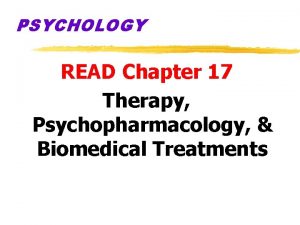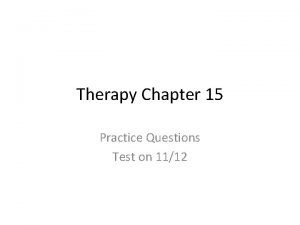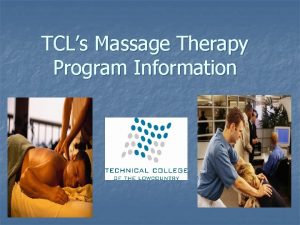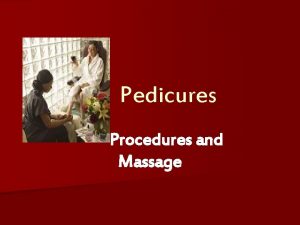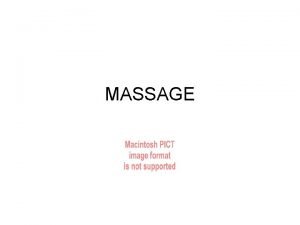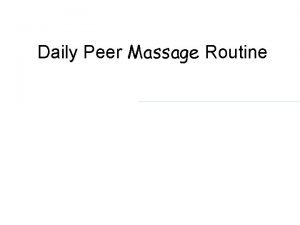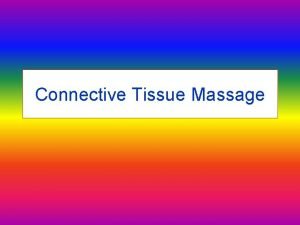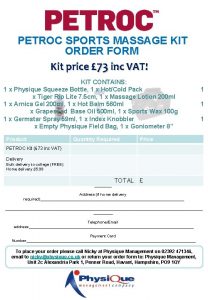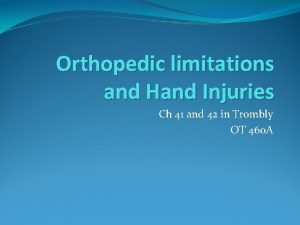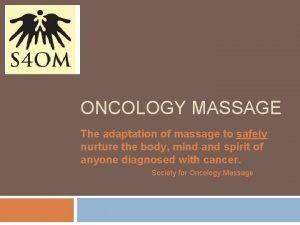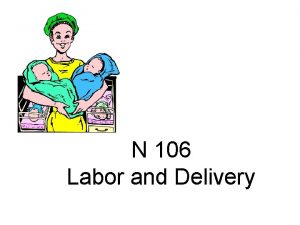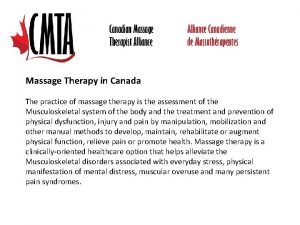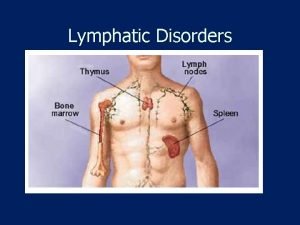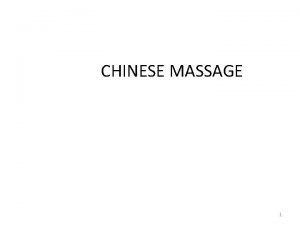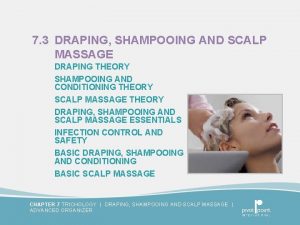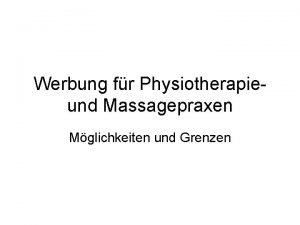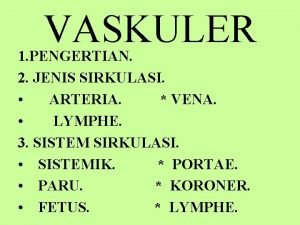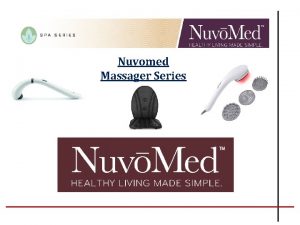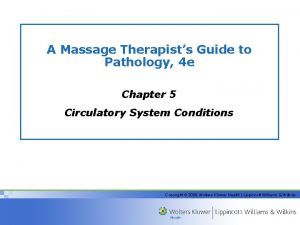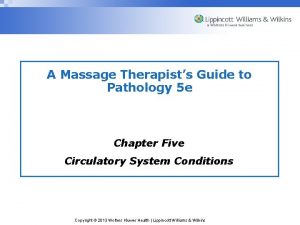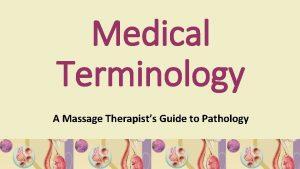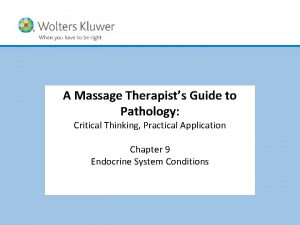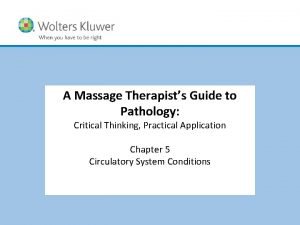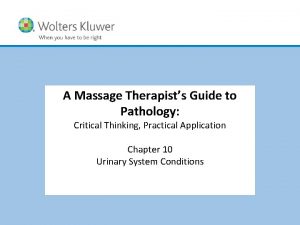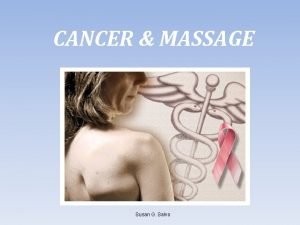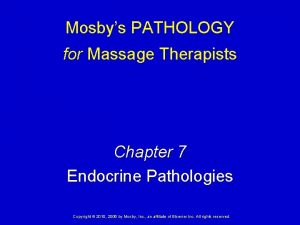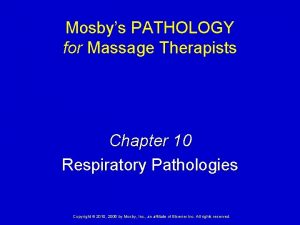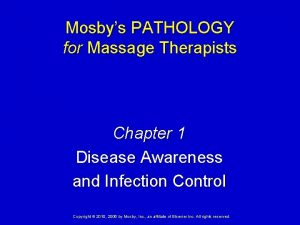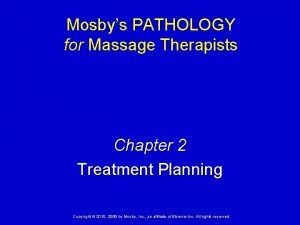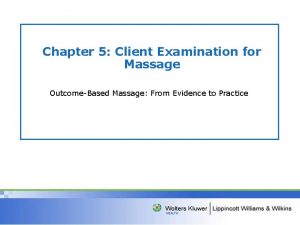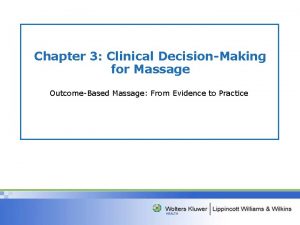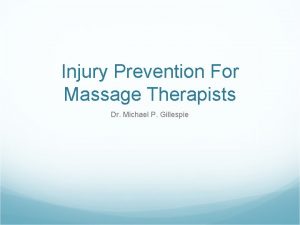A Massage Therapists Guide to Pathology Chapter One











































- Slides: 43

A Massage Therapist’s Guide to Pathology Chapter One Fundamental Concepts in Pathology Copyright © 2013 Wolters Kluwer Health | Lippincott Williams & Wilkins

Introduction • Part I: Terminology • Part II: Hygienic Practices • Part III: Infectious Agents • Part IV: The Inflammatory Process Copyright © 2013 Wolters Kluwer Health | Lippincott Williams & Wilkins

Terminology • A- , an-: without • Cep-, Ceph-: head, brain • Acro-: extremity • Chole: bile • Adeno-: glandular • Com-, con-: with, together • -Algia: pain • Contra-: against • Angio-: blood or lymph vessels • Cyst: hollow organ • Arthr-: joint • Derm-: skin • Brady-: slow • Carcin-: crab (cancer) • Cardio-: heart • Demo-: people • Dia-: through • Dys-: difficulty • Cervi-, cervico- : neck • Ecto-, -ectomy: outside, removal • -Cele: swelling, hernia • -Emia: blood Copyright © 2013 Wolters Kluwer Health | Lippincott Williams & Wilkins

Terminology • Endo-: inside • Hyper-: above, too much. • Epi- upon • Hypo-: below, too little • Erythr-: red • -Itis: inflammation • Ex-: out of • -Lepsis: seizure • -Gen: beginning, producing • Leuko-: white • Lipo-: fat • Glyco-: relating to sugar • -Graphy: recording, writing • Litho-: rock • -Logy: study • Hemo-: blood • Hemi-: one-half • -Lysis, -lyso: destruction • Hepat-: liver • Mega-: large • Hydro-: water • Meno-: month Copyright © 2013 Wolters Kluwer Health | Lippincott Williams & Wilkins

Terminology • Metr-: mother (uterus) • Onco-: tumor • Micro-: small • Orchi-: testes • Myco-: fungus • -Osis: pathologic condition • Mye-: marrow or spinal cord • Osteo-: bone • Myo-: muscle • Para-: alongside, near • Narco-: stupor • Peri-: around • Necro-: death • Phagia-: eating • Neo-: new • -Philia: affinity • Nephro-: kidney • Phleb-: vein • Neuro-: nerve • Phyto-: plants • -Oid: resembles • -Plasia: growth • -Oma: tumor • -Plasm, -plasma: formed Copyright © 2013 Wolters Kluwer Health | Lippincott Williams & Wilkins

Terminology • Patho-: disease state • Spondy-: spine • Physio-: nature • -Stasis: stagnation, standing still • Pseudo-: false • Stoma-: an opening; mouth • Psych-: the mind, mental • Syn-, Sym-: with • Ren-: kidney • Thrombo-: clot • -Rrhagia, -rrhea: flowing • Therm-: temperature • Rhino-: nose • Sarco-: flesh • -Trophy, -trophic: nutrition, growth • Sclero-: hardness, scarring • Vaso-: blood vessel Copyright © 2013 Wolters Kluwer Health | Lippincott Williams & Wilkins

Terminology • Acute • Lesion • Chronic • Morbidity • Complication • Mortality • Contraindicated • Pandemic • Demographic • Prevalence • Diagnosis • Prognosis • Endemic • Sign • Epidemic • Stenosis • Idiopathic • Subacute • Incidence • Symptom • Indication • Syndrome • Trauma Copyright © 2013 Wolters Kluwer Health | Lippincott Williams & Wilkins

Infectious agents Pathogen: disease-causing organism • Resistance is based on genetics, virulence, and lifestyle habits Five basic classes: • Prions • Viruses • Bacteria • Fungi • Animals Copyright © 2013 Wolters Kluwer Health | Lippincott Williams & Wilkins

Infectious agents • Prions No DNA, RNA Grow within CNS Spread through eating contaminated tissue, contaminated blood, transplant tissue, surgical tools – BSE (“mad cow”), CJD, kuru… Copyright © 2013 Wolters Kluwer Health | Lippincott Williams & Wilkins

Infectious agents • Viruses Packets of DNA, RNA wrapped in capsid (protein coat) Cannot replicate outside a host Reprogram target cell to produce virus Infected cells rupture, releasing viral copies Many disintegrate outside a host Some are stable, especially herpes simplex, hepatitis B, hepatitis C Copyright © 2013 Wolters Kluwer Health | Lippincott Williams & Wilkins

Infectious agents • Bacteria Single-celled microorganisms Can survive outside a host Not all pathogenic; some are beneficial Pathogenic bacteria attack cells/ release toxic wastes that damage cells Antibiotics interfere with bacterial reproduction (Slow-growing infections less responsive) Some bacteria have “spore”: tough waxy coat TB, tentanus, anthrax Copyright © 2013 Wolters Kluwer Health | Lippincott Williams & Wilkins

Infectious agents • Types of bacteria: – Cocci: spherical • Diplococci • Staphylococci • Associated with localized skin infections • Some are becoming antibioticresistant Copyright © 2013 Wolters Kluwer Health | Lippincott Williams & Wilkins

Infectious agents – Streptococci • Associated with systemic infections – Bacilli: elongated, rod-shaped (most likely to form spores) – Spirochetes: spiral-shaped – Mycoplasma: very tiny Copyright © 2013 Wolters Kluwer Health | Lippincott Williams & Wilkins

Infectious agents • Fungi – Yeasts and molds • Internal: associated with imbalance between yeasts and bacteria • External: skin infections Copyright © 2013 Wolters Kluwer Health | Lippincott Williams & Wilkins

Infectious agents • Animal parasites – Single or multi-cellular organisms – Live in or on a host – Can be vector for other diseases • Protozoa (Giardia, crypto) • Helminths and roundworms • Arthropods Head lice, crab lice, mites • Others Mosquitoes, ticks, fleas don’t live on or in host, but can spread disease Copyright © 2013 Wolters Kluwer Health | Lippincott Williams & Wilkins

Infectious agents Copyright © 2013 Wolters Kluwer Health | Lippincott Williams & Wilkins

Hygienic practices • Definition of terms – Cleaning – Disinfection – Sterilization – Sanitation – Plain soap – Antimicrobial soap – Detergent – Alcohol- based hand rub Copyright © 2013 Wolters Kluwer Health | Lippincott Williams & Wilkins

Hygienic practices • Universal and Standard Precautions Protection from infectious fluids: Semen Vaginal secretions Breast milk Cerebrospinal fluid Synovial fluid Pleural fluid Pericardial fluid Amniotic fluid Blood-tinged saliva Vomit (emesis) Copyright © 2013 Wolters Kluwer Health | Lippincott Williams & Wilkins

Hygienic practices • Hand washing – Work to preserve lipid layer, skin health • • – Transient bacteria: superficial, easy to remove Resident bacteria: deep, harder to remove (generally less aggressive) Running warm water, plain soap, 30 seconds • • Liquid soap is preferable Antimicrobial soap more likely to cause allergic reaction (Watching for increased bacterial resistance) Copyright © 2013 Wolters Kluwer Health | Lippincott Williams & Wilkins

Hygienic practices • Alcohol-based gels – Can be faster, more convenient – Doesn’t remove dirt – Use according to manufacturers’ recommendations • Alcohol-soaked towelettes not adequate • Moisturizing lotions are important Copyright © 2013 Wolters Kluwer Health | Lippincott Williams & Wilkins

Hygienic practices • Other Hand Care – Hang nails and other lesions • Cuticle nippers, cover sores – Trim, clean fingernails Copyright © 2013 Wolters Kluwer Health | Lippincott Williams & Wilkins

Hygienic practices • Care of surfaces, equipment – Goal: create an environment where nothing that one client touches directly or indirectly is touched by another client before it is cleaned Copyright © 2013 Wolters Kluwer Health | Lippincott Williams & Wilkins

Hygienic practices • Fabrics – All surfaces touched by client or therapist must be cleaned or replaced with each appointment – Linens, face cradle covers, bolster/pillow covers, etc. – Therapist clothing: consider changing shirt or apron with each client Copyright © 2013 Wolters Kluwer Health | Lippincott Williams & Wilkins

Hygienic practices • Laundering: – Professional laundering services use water that is 160º F (71º C), 25 minutes of agitation – 71 -77º F (21. 6 -25º C) with adequate detergent for anti-microbial effect – Bleach is most active at 135 -145º F (57. 262. 7º C), ratio of 50 -150 ppm (parts per million) Copyright © 2013 Wolters Kluwer Health | Lippincott Williams & Wilkins

Hygienic practices – Thoroughly rinse bleached laundry – Never leave laundry damp – Dry on high heat; iron for extra protection – Wrap, isolate clean laundry • Laundry services rent out sheets: little quality control • Other items must be laundered at home: – Clothing, bolster covers, face cradle covers, etc. • Watch for “seepage” of fluids through to fabrics usually covered by linens Copyright © 2013 Wolters Kluwer Health | Lippincott Williams & Wilkins

Hygienic practices • Other equipment • Swab massage tables, face cradles, vinyl-covered furniture – CDC recommends 10% bleach solution Loses potency quickly: replace often Alcohol evaporates too quickly to be useful – Isolate massage lubricants Solid at room temperature: individual dispensers – Wash oil/lotion bottles with hands – Keep bottles off floor, other contaminated surfaces Copyright © 2013 Wolters Kluwer Health | Lippincott Williams & Wilkins

Hygienic practices • Other items: – Hot or cold rocks and crystals may be sterilized – Tools, hot/cold packs, etc: wash contacting surfaces • The massage environment – Curtains, upholstery, carpets probably not major vectors Can harbor allergens: vacuum regularly If carpet gets wet, can grow mold: replace – Other surfaces should be cleaned frequently: Door knobs, switch plates, bathroom surfaces, telephones, etc. – Cash is often contaminated Copyright © 2013 Wolters Kluwer Health | Lippincott Williams & Wilkins

The inflammatory process • What is inflammation? • Response to tissue damage or the threat of invasion by antigens – Triggered by Physical trauma Invasion with foreign bodies Hormonal changes, Autoimmune activity Copyright © 2013 Wolters Kluwer Health | Lippincott Williams & Wilkins

The inflammatory process • Purpose: – Protect from pathogenic invasion – Limit range of contamination – Prepare damaged area for healing • Outcomes: – Complete resolution with no scar tissue – Accumulation of scar tissue – Formation of cysts/abscesses – Chronic inflammation • See the. Point. lwww/Werner 5 e for more on inflammation Copyright © 2013 Wolters Kluwer Health | Lippincott Williams & Wilkins

The inflammatory process • Components of inflammation: vascular activity – Vasoconstriction • Protective response, short-lived – Vasodilation • Chemicals released by damaged endothelium and mast cells Increase permeability of capillaries Reinforce capillary dilation Attract platelets Slow blood flow away from area – May last several minutes to hours or days Copyright © 2013 Wolters Kluwer Health | Lippincott Williams & Wilkins

The inflammatory process • (See Figure 1. 10 a and 1. 10 b) Copyright © 2013 Wolters Kluwer Health | Lippincott Williams & Wilkins

The inflammatory process • Components of inflammation: cellular activity – Many cells are recruited to manage tissue damage and contamination risk with injury. • Endothelial cells: – Release chemicals to activate platelets, allow WBCs to migrate out of capillaries – Proliferate to grow new capillary beds in later stages • Platelets: – Become jagged and sticky, adhere to damaged area – Release chemicals to bind with plasma proteins to create fibrin, blood clots Copyright © 2013 Wolters Kluwer Health | Lippincott Williams & Wilkins

The inflammatory process • White blood cells: – Several types involved: • Granulocytes: • Smallest, fastest • Neutrophils 1 st on the scene for bacterial infection, musculoskeletal injury • Eosinophils for allergies, parasites • Basophils for allergies and histamine release Copyright © 2013 Wolters Kluwer Health | Lippincott Williams & Wilkins

The inflammatory process • Mast cells: – Located in tissues vulnerable to injury – Release histamine to prolong inflammatory response • Monocytes and macrophages: – Monocytes = large, mobile white blood cells – Can become permanently fixed macrophages – Associated with late-stage inflammation to clean up debris • Lymphocytes: – Work with macrophages to clean up debris, promote scar tissue, angiogenesis Copyright © 2013 Wolters Kluwer Health | Lippincott Williams & Wilkins

The inflammatory process • Fibroblasts – Produce collagen, extracellular matrix – Drawn to local blood clots, may proliferate to form more scar tissue Copyright © 2013 Wolters Kluwer Health | Lippincott Williams & Wilkins

The inflammatory process • Chemical mediators – Many sources of chemical mediators that help coordinate cellular activity: • Suspended in plasma, from platelets, mast cells, basophils, endothelial cells… Copyright © 2013 Wolters Kluwer Health | Lippincott Williams & Wilkins

The inflammatory process Stages of healing • Acute stage – Damaged cells release chemicals – Edema develops – Platelets, early WBCs arrive – Tissue exudate begins to form – Time: depends on severity (1 -3 days, usually) Copyright © 2013 Wolters Kluwer Health | Lippincott Williams & Wilkins

The inflammatory process • Subacute stage – AKA proliferative stage – Cells accumulate to fill in damaged area • Endothelial cells grow new capillaries • Fibroblasts create collagen fibers – Slower WBCs arrive to start clean-up – Time: depends; 2 -3 weeks Copyright © 2013 Wolters Kluwer Health | Lippincott Williams & Wilkins

The inflammatory process • Postacute stage – AKA maturation stage – Collagen becomes denser and aligns according to force Copyright © 2013 Wolters Kluwer Health | Lippincott Williams & Wilkins

The inflammatory process • Chronic inflammation – Inflammatory process is not successful • Pathogens/irritants not removed (leads to cysts, abscesses) • Excessive scar tissue interferes with organ function • Sinuses or fistulae develop • Musculoskeletal structures never regain full function: tendinosis • Excessive external scar tissue Copyright © 2013 Wolters Kluwer Health | Lippincott Williams & Wilkins

The inflammatory process Signs and symptoms: • Pain, heat, redness, swelling, and sometimes loss of function – Dolor (pain) – Calor (heat) – Rubor (redness) – Tumor (swelling) and – Functio Laesa (loss of function) Copyright © 2013 Wolters Kluwer Health | Lippincott Williams & Wilkins

The inflammatory process • Treatment: – Anti-inflammatory drugs • Medications: – OTC anti-inflammatories – Prescription NSAIDs – Prescription steroidal anti-inflammatories Copyright © 2013 Wolters Kluwer Health | Lippincott Williams & Wilkins

The inflammatory process • Massage – Risks: Acute localized infections locally contraindicate circulatory massage – Benefits: Post acute, maturation phase can benefit from fluid turnover, mechanical influence on scar tissue Copyright © 2013 Wolters Kluwer Health | Lippincott Williams & Wilkins
 Royal college of occupational therapists
Royal college of occupational therapists Client centered therapists try to appreciate
Client centered therapists try to appreciate Which of the following therapists would most likely
Which of the following therapists would most likely Chapter 17 oral pathology
Chapter 17 oral pathology One god one empire one religion
One god one empire one religion One one little dog run
One one little dog run One king one law one faith
One king one law one faith One empire one god one emperor
One empire one god one emperor Ford one plan
Ford one plan See one do one teach one
See one do one teach one See one, do one, teach one
See one, do one, teach one Willow cabin speech
Willow cabin speech Studiendekanat uni bonn
Studiendekanat uni bonn Asean tourism strategic plan
Asean tourism strategic plan Asean one vision one identity one community
Asean one vision one identity one community Tcl massage
Tcl massage Uyan nomo anwendung
Uyan nomo anwendung Guam massage parlors
Guam massage parlors Carole osborne sheets
Carole osborne sheets Pedicure materials
Pedicure materials Definition of massage
Definition of massage Lux massage
Lux massage Keva body oil
Keva body oil Peer massage routine
Peer massage routine Ctm massage
Ctm massage Chinese good massage 1
Chinese good massage 1 Rotary shampooing techniques
Rotary shampooing techniques Petrissage hair massage
Petrissage hair massage Body massage kit price
Body massage kit price Manual edema mobilization vs retrograde massage
Manual edema mobilization vs retrograde massage Chinese massage inguenal
Chinese massage inguenal What are the mechanisms of labor
What are the mechanisms of labor Cmta massage
Cmta massage Ear lobe massage
Ear lobe massage Lymphatic drainage massage buttocks
Lymphatic drainage massage buttocks Xxx japanese hot massage
Xxx japanese hot massage Hestens normale puls
Hestens normale puls Chinese massage 1
Chinese massage 1 Humectants milady
Humectants milady Outcome based massage
Outcome based massage How does shampoo draping differ from chemical draping
How does shampoo draping differ from chemical draping Fr
Fr Intermetten
Intermetten China massage wand
China massage wand

